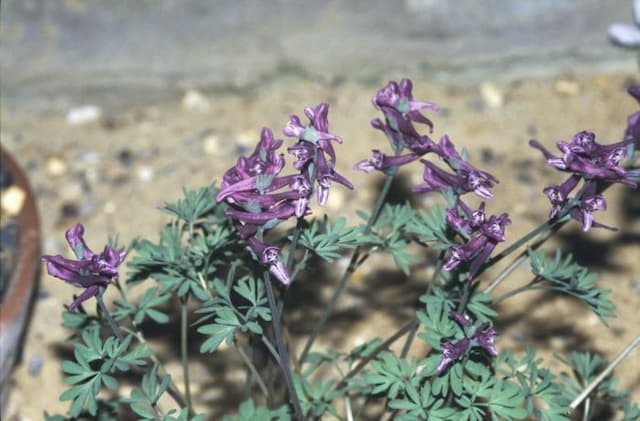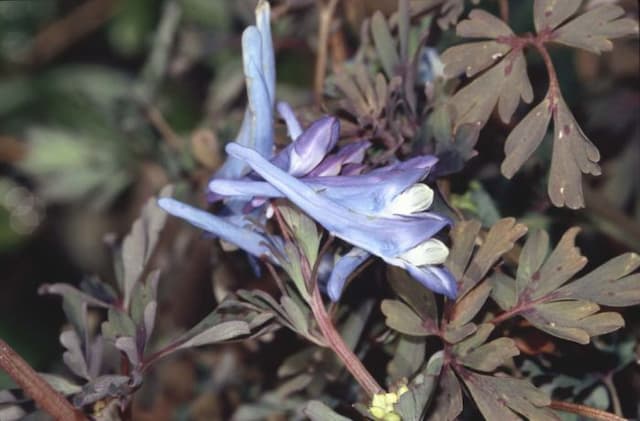Corn poppy Papaver rhoeas 'Bridal Silk'

ABOUT
The 'Bridal Silk' poppy is a captivating flowering plant known for its soft, delicate white petals that give it a silky, almost ethereal look. These flowers are reminiscent of exquisite bridal gowns, hence the charming name. Each flower comprises large, rounded petals that create a graceful, cup-shaped form. The center of the bloom displays a dark, contrasting cluster of stamens that add depth to the flower's appearance and attract pollinators. The plant has a clumping growth habit, with slender, hairy stems that elegantly support the weight of the blooms. The foliage is a rich green hue and typically consists of deeply lobed leaves. These leaves can add texture and visual interest to the overall silhouette of the plant, making it not only appreciated for its showy flowers but also its lush foliage. The 'Bridal Silk' poppy adds a touch of romance to any garden setting with its pure, unblemished color palette. Its blossoms are celebrated for their ephemeral beauty, often associated with remembrance and tranquility in the world of flowers. This plant is an ornamental gem, providing a softening effect amongst more vibrant garden companions and showcasing nature's ability to produce the most delicate and stunning displays.
About this plant
 Names
NamesFamily
Papaveraceae.
Synonyms
Common Poppy, Corn Poppy, Field Poppy, Flanders Poppy, Red Poppy, Corn Rose, Headache Flower, Headwark.
Common names
Papaver rhoeas 'Bridal Silk'.
 Characteristics
CharacteristicsLife cycle
Annuals
Foliage type
Deciduous
Color of leaves
Green
Flower color
White
Height
2 feet (60 cm)
Spread
1 foot (30 cm)
Plant type
Herb
Hardiness zones
6
Native area
Eurasia
Benefits
 General Benefits
General Benefits- Enhances garden aesthetics: Adds delicate white blossoms that provide a soft, romantic feel to garden landscapes.
- Attracts beneficial insects: Welcomes pollinators like bees and butterflies, supporting local ecosystems.
- Easy to grow: Adapts well to various soils and conditions, making it ideal for novice gardeners.
- Low maintenance: Requires minimal care beyond basic watering and occasional fertilization.
- Drought-tolerant: Once established, it can survive with infrequent watering, conserving water resources.
- Annual life cycle: Completes its life in one growing season, which can prevent the dominance of other, potentially invasive species.
- Self-seeding: Can naturally reseed itself, ensuring the presence of the flower in the garden for subsequent years without additional planting.
- Non-invasive: Unlike some other poppies, this cultivar is not aggressive, reducing the risk of it taking over garden spaces.
- Symbolic significance: Historically associated with remembrance and peace, adding a layer of meaning to its presence in a garden.
- Cultural appeal: Popular in cottage gardens and traditional landscapes, making it a timeless choice for garden design.
 Medical Properties
Medical Properties- Sedative: Commonly known as the corn poppy, Papaver rhoeas has been used for its mild sedative effects, which can help alleviate anxiety and promote sleep.
- Expectorant: The plant has expectorant properties, which may aid in the relief of coughs.
- Analgesic: It has been used to provide pain relief for various ailments.
- Anti-inflammatory: The flower's petals contain compounds with anti-inflammatory effects that can help reduce inflammation.
 Air-purifying Qualities
Air-purifying QualitiesThis plant is not specifically known for air purifying qualities.
 Other Uses
Other Uses- Corn poppy petals can be used as a natural dye for fabrics, providing a soft red hue to textiles.
- The seeds of the corn poppy can be mixed with birdseed blends to provide nutrition to wild birds.
- Pressed corn poppy flowers are often used in crafts and jewelry making for their delicate beauty.
- Corn poppy petals can serve as a colorful garnish for salads and desserts, adding a vibrant touch to culinary presentations.
- Dried corn poppy plants can be incorporated into potpourri mixes for their visual appeal and subtle fragrance.
- Corn poppy flowers can be used as a biodegradable confetti alternative for events, being both eco-friendly and picturesque.
- The stems and seedpods of corn poppies, when dried, make interesting additions to floral arrangements and wreaths.
- The vivid red of corn poppy petals can be used in artisanal paper making to create unique, colorful paper products.
- Children can use the hollow stems of corn poppies to create natural whistles or simple musical instruments.
- Corn poppy fields can act as a temporary habitat for beneficial insects and pollinators, supporting local biodiversity.
Interesting Facts
 Feng Shui
Feng ShuiThe common poppy is not used in Feng Shui practice.
 Zodiac Sign Compitability
Zodiac Sign CompitabilityThe common poppy is not used in astrology practice.
 Plant Symbolism
Plant Symbolism- Peace - The Papaver rhoeas, commonly known as poppy, is often used as a symbol of peace and is worn as a remembrance of those who lost their lives during war, especially after World War I.
- Remembrance - Poppies are commonly associated with remembrance due to their presence on European battlefields of World War I, leading to their symbolism for honoring fallen soldiers.
- Rest - The poppy flower, due to its sedative properties, has historically symbolized sleep and rest.
- Beauty and Success - With its delicate and beautiful petals, the 'Bridal Silk' variety of poppy may be used to symbolize beauty and success in a new marriage or endeavor.
- Consolation - Poppies can represent consolation for loss and are used in funerals and remembrance services.
 Water
WaterCommon poppy should be watered sparingly, as it is tolerant of dry conditions and overwatering can lead to root rot. During the growing season, water the plant only when the top inch of soil has dried out, which typically means about once a week, depending on weather conditions. Use about half a gallon of water per plant, ensuring you water the base and not the foliage to prevent fungal diseases. Reduce watering frequency once the plant has finished blooming and is going dormant.
 Light
LightCommon poppy thrives in full sun, meaning it should receive at least six hours of direct sunlight per day. The best spot for this plant is in an area where it can soak up the sun's rays without being shaded by larger plants or structures. Avoid planting it in areas prone to overcast conditions or where there are long periods of shade during the day.
 Temperature
TemperatureCommon poppy prefers moderate to warm conditions and can tolerate temperatures as low as 14°F in dormancy. Ideally, maintain an environment where daytime temperatures hover between 60°F and 70°F for optimal growth. They can survive up to 90°F but may require additional watering to cope with the heat. Always ensure that the plant is not exposed to frost, as it is not frost-hardy.
 Pruning
PruningRegular pruning of common poppy is not necessary. Prune to remove spent flowers, which can promote a second bloom in some varieties, and deadhead to prevent self-sowing if desired. The best time for pruning is after the flowering period, when the petals have faded and before the seed pods have fully matured.
 Cleaning
CleaningAs needed
 Soil
SoilCorn poppy 'Bridal Silk' grows best in well-draining soil with a pH of 6.0-7.5. A mix of loamy soil, compost, and sand can provide adequate drainage and nutrients. Avoid waterlogged conditions.
 Repotting
RepottingCorn poppies, including the 'Bridal Silk' variety, are annuals and do not require repotting as they complete their life cycle in one season.
 Humidity & Misting
Humidity & MistingCorn poppies like 'Bridal Silk' are not particularly humidity-sensitive and can thrive in average outdoor humidity levels.
 Suitable locations
Suitable locationsIndoor
Ensure full sun, well-draining soil, and occasional watering.
Outdoor
Choose a sunny spot, sow in spring, ensure well-drained soil.
Hardiness zone
2-11 USDA
 Life cycle
Life cyclePapaver rhoeas 'Bridal Silk', commonly known as the Bridal Silk poppy, begins its life cycle as a seed, often sown after the danger of frost has passed in the spring. After germination, the plant emerges as a seedling with a rosette of leaves close to the ground. As it matures, it develops a slender, erect stem and produces distinctive, deeply lobed leaves. The Bridal Silk poppy then blooms in late spring to early summer, producing large, silky white flowers with a central cluster of stamens. Once pollinated, typically by insects, the flowers form seed pods that eventually dry and release seeds for future generations. The plant completes its life cycle by dying back after seed dispersal, as it is an annual species.
 Propogation
PropogationPropogation time
Spring-Early Summer
Propogation: The common poppy, specifically Papaver rhoeas 'Bridal Silk', is best propagated by seed. Propagation time for these seeds typically begins in the fall, as they require a period of cold stratification to germinate effectively. To propagate the common poppy 'Bridal Silk' by seed, scatter the seeds over a well-drained soil in a sunny location, lightly pressing them into the soil surface. As these seeds need light to germinate, they should not be covered with soil, but a light sprinkling of vermiculite can help retain moisture. Water the area gently using a misting spray as to not disturb the seeds. Germination usually happens within two weeks once temperatures are around 60 to 68 degrees Fahrenheit (15 to 20 degrees Celsius). It's important to maintain even moisture during germination, but once established, common poppies are fairly drought tolerant.









